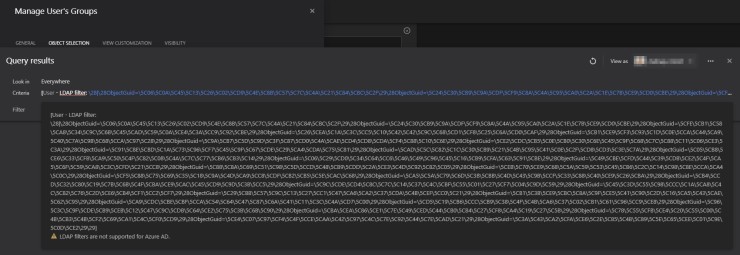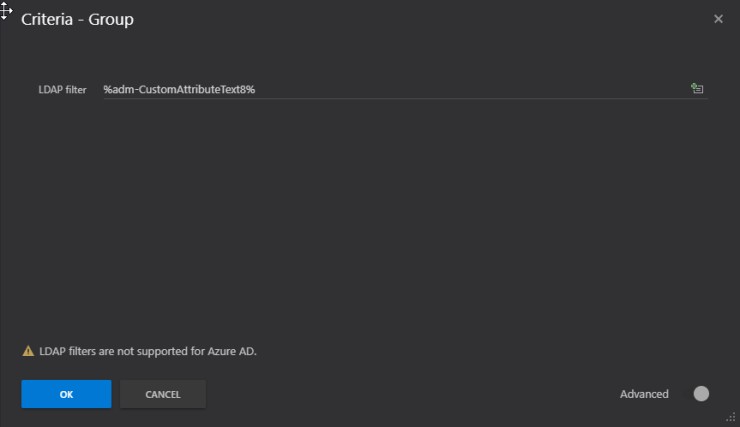Hi,
I recently upgraded Adaxes from 2021.1 to 2023.2, and after the upgrade, an LDAP filter for retrieving the groups a user is owner of, stopped working.
The reason it stopped working is because all the paranthesis and backslashes in the string gets escaped.
From this:
(|(ObjectGuid=\06\0A\45\13\26\02\D9\4E\8B\57\7C\4A\21\84\BC\2F)(ObjectGuid=\24\30\B9\9A\DF\F9\8A\4A\95\A0\2A\1E\7B\E9\D0\BE)(ObjectGuid=\FE\B1\58\A8\34\9C\6B\45\AD\59\0A\E4\3A\C9\92\BE)(ObjectGuid=\26\EA\1A\3C\C5\10\42\42\9C\68\D1\F8\25\6A\D0\AF)(ObjectGuid=\B1\E9\F3\93\1D\0E\CA\44\A9\40\7A\9B\68\CA\97\28)(ObjectGuid=\9A\B7\5D\9D\3F\87\D0\4A\AE\D4\D8\DA\F4\88\10\6E)(ObjectGuid=\E2\DC\B5\0E\B0\30\6E\45\9F\68\7C\88\11\06\E3\3A)(ObjectGuid=\91\8E\BD\1A\73\96\F7\45\9F\67\DE\29\A4\DA\75\81)(ObjectGuid=\AD\5C\82\1C\30\B9\21\4B\95\41\0E\2F\D8\D3\3E\7A)(ObjectGuid=\05\B8\E6\33\FB\A9\50\4F\82\08\4A\7C\77\B6\B3\14)(ObjectGuid=\06\29\D0\34\64\C6\46\49\96\45\16\B9\FA\63\91\BE)(ObjectGuid=\49\BE\FD\44\39\DB\E2\4F\A5\6F\59\A8\3C\FD\21\C8)(ObjectGuid=\88\8A\69\51\98\5D\CD\48\B9\DD\2A\E3\4D\92\82\05)(ObjectGuid=\EB\70\E9\68\5A\59\53\45\B6\2C\14\98\8E\CA\A4\0C)(ObjectGuid=\F5\88\75\69\35\18\9A\4D\A9\C8\DF\B2\B5\5E\AC\68)(ObjectGuid=\A5\5A\79\6D\3B\BB\4D\43\9B\CF\33\88\40\E9\26\BA)(ObjectGuid=\B4\CD\32\80\19\7B\6B\4F\BA\E9\AC\45\D9\9D\3B\C5)(ObjectGuid=\9C\DE\D4\8C\7C\14\37\4C\BF\55\01\27\F7\04\9D\59)(ObjectGuid=\45\3D\55\98\CC\1A\A8\4C\82\76\2D\E6\B4\F1\C2\F7)(ObjectGuid=\29\BB\57\9C\13\27\C1\47\A6\A2\37\DA\4B\EF\C0\21)(ObjectGuid=\B1\3B\E9\BC\8A\9F\E5\41\90\2D\16\A5\43\AE\62\95)(ObjectGuid=\A9\DC\BE\BF\CA\54\64\47\87\6A\41\11\3C\4A\D7\00)(ObjectGuid=\D5\19\B6\CC\B9\38\4F\4B\A6\37\02\B1\61\96\C9\E8)(ObjectGuid=\96\3C\9F\DE\B9\EB\12\47\9C\DB\64\E2\75\3B\6B\90)(ObjectGuid=\BA\EA\86\E1\7E\49\ED\44\B0\B4\27\F8\A4\19\27\5B)(ObjectGuid=\78\55\FB\E4\20\55\00\4B\B3\4B\F2\69\A1\4C\F0\D9)(ObjectGuid=\E4\07\97\F4\4F\CE\AA\42\97\4C\7E\92\44\7E\AD\21)(ObjectGuid=\3A\43\A2\FA\E6\2E\85\4B\89\5E\65\EE\01\9E\0D\E2))
To this:
\28|\28ObjectGuid=\5C06\5C0A\5C45\5C13\5C26\5C02\5CD9\5C4E\5C8B\5C57\5C7C\5C4A\5C21\5C84\5CBC\5C2F\29\28ObjectGuid=\5C24\5C30\5CB9\5C9A\5CDF\5CF9\5C8A\5C4A\5C95\5CA0\5C2A\5C1E\5C7B\5CE9\5CD0\5CBE\29\28ObjectGuid=\5CFE\5CB1\5C58\5CA8\5C34\5C9C\5C6B\5C45\5CAD\5C59\5C0A\5CE4\5C3A\5CC9\5C92\5CBE\29\28ObjectGuid=\5C26\5CEA\5C1A\5C3C\5CC5\5C10\5C42\5C42\5C9C\5C68\5CD1\5CF8\5C25\5C6A\5CD0\5CAF\29\28ObjectGuid=\5CB1\5CE9\5CF3\5C93\5C1D\5C0E\5CCA\5C44\5CA9\5C40\5C7A\5C9B\5C68\5CCA\5C97\5C28\29\28ObjectGuid=\5C9A\5CB7\5C5D\5C9D\5C3F\5C87\5CD0\5C4A\5CAE\5CD4\5CD8\5CDA\5CF4\5C88\5C10\5C6E\29\28ObjectGuid=\5CE2\5CDC\5CB5\5C0E\5CB0\5C30\5C6E\5C45\5C9F\5C68\5C7C\5C88\5C11\5C06\5CE3\5C3A\29\28ObjectGuid=\5C91\5C8E\5CBD\5C1A\5C73\5C96\5CF7\5C45\5C9F\5C67\5CDE\5C29\5CA4\5CDA\5C75\5C81\29\28ObjectGuid=\5CAD\5C5C\5C82\5C1C\5C30\5CB9\5C21\5C4B\5C95\5C41\5C0E\5C2F\5CD8\5CD3\5C3E\5C7A\29\28ObjectGuid=\5C05\5CB8\5CE6\5C33\5CFB\5CA9\5C50\5C4F\5C82\5C08\5C4A\5C7C\5C77\5CB6\5CB3\5C14\29\28ObjectGuid=\5C06\5C29\5CD0\5C34\5C64\5CC6\5C46\5C49\5C96\5C45\5C16\5CB9\5CFA\5C63\5C91\5CBE\29\28ObjectGuid=\5C49\5CBE\5CFD\5C44\5C39\5CDB\5CE2\5C4F\5CA5\5C6F\5C59\5CA8\5C3C\5CFD\5C21\5CC8\29\28ObjectGuid=\5C88\5C8A\5C69\5C51\5C98\5C5D\5CCD\5C48\5CB9\5CDD\5C2A\5CE3\5C4D\5C92\5C82\5C05\29\28ObjectGuid=\5CEB\5C70\5CE9\5C68\5C5A\5C59\5C53\5C45\5CB6\5C2C\5C14\5C98\5C8E\5CCA\5CA4\5C0C\29\28ObjectGuid=\5CF5\5C88\5C75\5C69\5C35\5C18\5C9A\5C4D\5CA9\5CC8\5CDF\5CB2\5CB5\5C5E\5CAC\5C68\29\28ObjectGuid=\5CA5\5C5A\5C79\5C6D\5C3B\5CBB\5C4D\5C43\5C9B\5CCF\5C33\5C88\5C40\5CE9\5C26\5CBA\29\28ObjectGuid=\5CB4\5CCD\5C32\5C80\5C19\5C7B\5C6B\5C4F\5CBA\5CE9\5CAC\5C45\5CD9\5C9D\5C3B\5CC5\29\28ObjectGuid=\5C9C\5CDE\5CD4\5C8C\5C7C\5C14\5C37\5C4C\5CBF\5C55\5C01\5C27\5CF7\5C04\5C9D\5C59\29\28ObjectGuid=\5C45\5C3D\5C55\5C98\5CCC\5C1A\5CA8\5C4C\5C82\5C76\5C2D\5CE6\5CB4\5CF1\5CC2\5CF7\29\28ObjectGuid=\5C29\5CBB\5C57\5C9C\5C13\5C27\5CC1\5C47\5CA6\5CA2\5C37\5CDA\5C4B\5CEF\5CC0\5C21\29\28ObjectGuid=\5CB1\5C3B\5CE9\5CBC\5C8A\5C9F\5CE5\5C41\5C90\5C2D\5C16\5CA5\5C43\5CAE\5C62\5C95\29\28ObjectGuid=\5CA9\5CDC\5CBE\5CBF\5CCA\5C54\5C64\5C47\5C87\5C6A\5C41\5C11\5C3C\5C4A\5CD7\5C00\29\28ObjectGuid=\5CD5\5C19\5CB6\5CCC\5CB9\5C38\5C4F\5C4B\5CA6\5C37\5C02\5CB1\5C61\5C96\5CC9\5CE8\29\28ObjectGuid=\5C96\5C3C\5C9F\5CDE\5CB9\5CEB\5C12\5C47\5C9C\5CDB\5C64\5CE2\5C75\5C3B\5C6B\5C90\29\28ObjectGuid=\5CBA\5CEA\5C86\5CE1\5C7E\5C49\5CED\5C44\5CB0\5CB4\5C27\5CF8\5CA4\5C19\5C27\5C5B\29\28ObjectGuid=\5C78\5C55\5CFB\5CE4\5C20\5C55\5C00\5C4B\5CB3\5C4B\5CF2\5C69\5CA1\5C4C\5CF0\5CD9\29\28ObjectGuid=\5CE4\5C07\5C97\5CF4\5C4F\5CCE\5CAA\5C42\5C97\5C4C\5C7E\5C92\5C44\5C7E\5CAD\5C21\29\28ObjectGuid=\5C3A\5C43\5CA2\5CFA\5CE6\5C2E\5C85\5C4B\5C89\5C5E\5C65\5CEE\5C01\5C9E\5C0D\5CE2\29\29
This is how it appears in the interface:

This is how it is configured:

Any tips on how to prevent this from happening?
I also tried using a normal filter based on the "owners (Managed by)" attribute instead, like this:

It works, but sadly it is quite slow.
Best regards
Martin